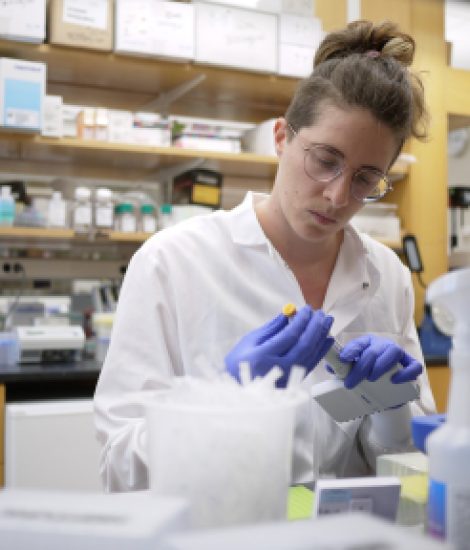My PD Story

Inés Patop, PhD
2024 Postdoctoral Fellowship
Investigating How Parkinson’s Derails Crucial Transport Routes Within Neurons
Neurons, the cell type that transmits information in our brain and nervous system, are complex in ways that have puzzled researchers for decades. Depending on their location and role in the body, neurons can vary wildly in shape and activity, with some stretching up to a meter in length to perform their signaling duties. Their unique form and function also create challenges for neurons, having to manage cellular upkeep across long distances to stay fit and functional.
The dopamine-producing neurons in the brain progressively lost in Parkinson’s disease (PD) are no exception. How the disease may impact the cells’ critical maintenance is still not well understood. Inés Patop, PhD, recipient of a Parkinson’s Foundation Postdoctoral Fellowship, will be utilizing new and sophisticated biological tools to improve our understanding of not just how PD may affect neuronal upkeep, but specifically where it is most damaging within the cell and how we can use that knowledge to design more efficient therapies.
While their shape and size vary across the body, all neurons are composed of two distinct parts:
-
The soma: the larger main area of the cell that contains the DNA-storing nucleus
-
The neurites: the tendril-like extensions that reach out to other cells to either receive signals (as dendrites) or convey signals (as axons).
In each of these parts are mitochondria, miniature cell powerplants that require routine maintenance to keep the cell working properly. Parkinson’s disease has been associated with mitochondria misfunction for more than 30 years, being most of the PD-associated mutations involved in the process of clearing defective mitochondria.
The trick is that the blueprints needed for proper mitochondrial function and to repair and clear defective mitochondria come from the nucleus in the soma, so to maintain or clear the far-away mitochondria in the neurites, the neuron needs to print and transport those blueprints (called RNA) across the cell. That process requires significant coordination to execute properly, coordination that is likely disrupted in neurons affected by PD-associated mutations.
From the lab of Dr. Stirling Churchman at Harvard University in Boston, MA, Dr. Patop will utilize special growing chambers that will allow them to isolate and study the soma and neurites of neurons individually. They will then run complex biochemical analyses to see how RNA printing and transport, mitochondria repair and more differ between the distinct cell regions, and how each is affected by PD mutations. From this data, Dr. Patop hopes to better understand how PD may affect neurons differently from soma to dendrites, potentially leading to new future treatments that target the most impacted regions of the cells.
When asked what the Parkinson’s Foundation research funding means to them, they said, “I am confident this opportunity will lay a strong foundation for my future career, empowering me to make meaningful contributions to the scientific community and, ultimately, improve the lives of those affected by Parkinson's disease. Through this research, we expect to identify new regulatory mechanisms implicated in PD, potentially identifying novel drug targets for treatment. The impact of this research could significantly advance our understanding of PD and pave the way for innovative therapeutic strategies.”
Meet more Parkinson’s researchers! Explore our My PD Stories featuring PD researchers.
Related Materials
More Stories
from the Parkinson's community


